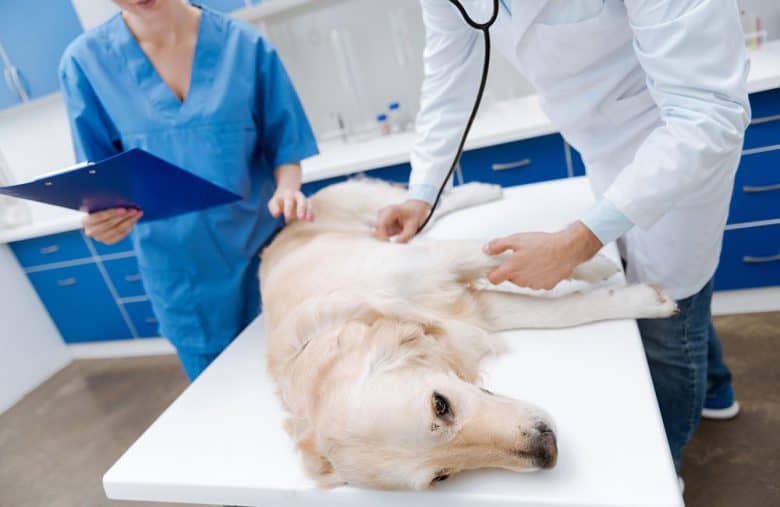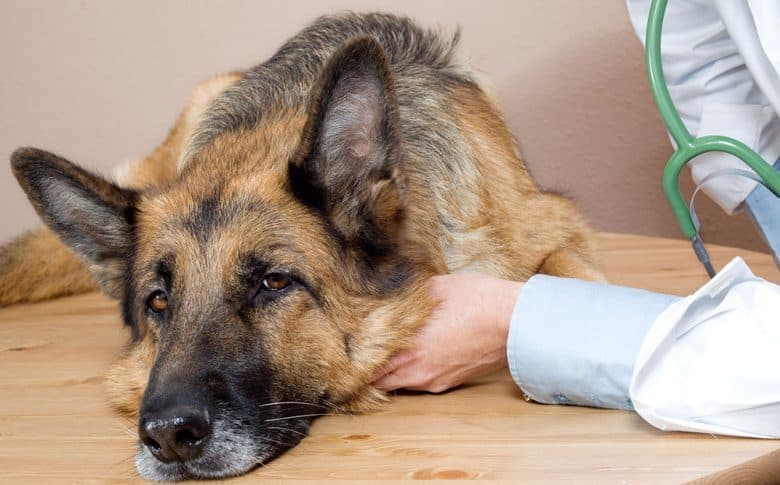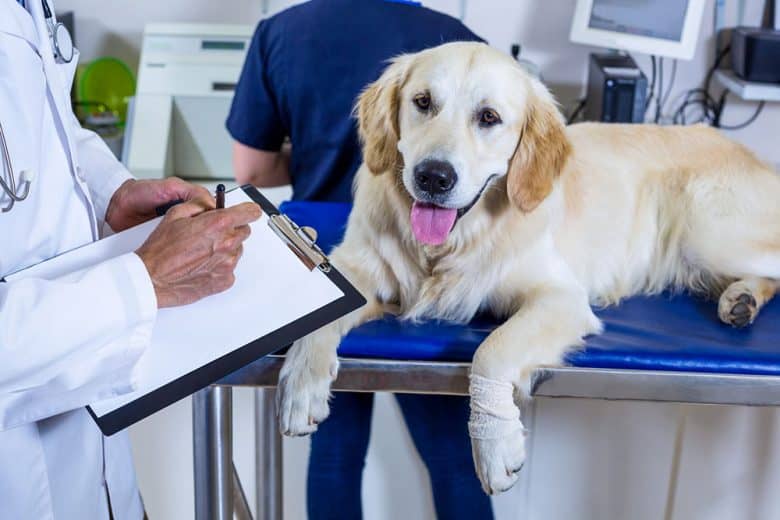Last Updated on April 15, 2023
Any dog lover wants the best for their pet, but certain health conditions are inevitable, just like canine epilepsy.
It can affect any breed regardless of size, and if your dog is having seizures, you’ll want to know how to face the issue and help your dog.

What else should you look out for? Is canine epilepsy curable? Why do dogs get it? Keep scrolling and have your questions answered.
Quick Navigation
- 1 What is Canine Epilepsy?
- 2 What are the symptoms of a dog seizure?
- 3 The etiology of epilepsy
- 4 What can trigger a seizure in a dog?
- 5 What should you do if your dog is having a seizure?
- 6 Diagnosing canine epilepsy
- 7 How are seizures treated or prevented?
- 8 Life for Dogs With Canine Epilepsy
- 9 Frequently Asked Questions
- 10 Tips for Responsible Dog Owners
- 11 The Future of Epilepsy
- 12 Further reading:
- 13 Reference
What is Canine Epilepsy?
This illness is a nervous system disorder that leads to mild or severe convulsions. And seizures are the most common neurological condition in dogs.
But it’s best that we clarify that seizures and epileptic seizures aren’t the same thing.
A seizure is a singular event classified as a temporary and involuntary disturbance of normal brain function. It means your dog can experience it once, and it may never happen again.
With epilepsy, it is a disease characterized as multiple recurring or unprovoked seizures. Therefore, to be classified as epilepsy, there must be an ongoing incidence rate.
So if your dog has a seizure, don’t assume that he’s epileptic.
Primary & Secondary Canine Epilepsy
Primary epilepsy is typically called generalized epilepsy, and seizures with no known cause characterize it. This stems from the diagnosed disease itself, which garners it the designation of primary.
Secondary epilepsy is characterized by seizures that are symptoms of a diagnosed condition. The cause can be traced back to things such as brain trauma, anemia, liver disease, or even a stroke.
What are the symptoms of a dog seizure?

There can be noticeable signs that your pup is about to experience a seizure. They may bark excessively, act confused, appear uncoordinated, show restlessness, or even become clingy.
Some of these symptoms may not seem out of the ordinary for some dog owners, but for those with epileptic dogs, you’ll want to learn to recognize these indicators.
During a seizure, you may notice your dog:
- Twitching
- Collapse
- loss of consciousness
- Peeing
- Defecating
- excessive salivation
- foaming at the mouth
- stiffening up
- chewing their tongue
- Chomping
- Paddling
Your dog can be confused, uncoordinated, dizzy, drooling, or temporarily blind after the seizure. He may also uncontrollably pee or poop, eat and drink excessively, and they could vomit.
Fair warning: Before you watch this video, don’t get upset to see dogs experiencing seizures. We’re hoping that you can learn from it so you can help your dog or someone else’s pet who have this disease:
The Stages of a seizure
Canine seizures have several stages to the event, and a possible prodrome phase may precede those three stages.
Prodrome
Prodrome is a pre-seizure phase where indications of an upcoming event may present themselves.
It can last hours or even days, and you may see your dog display unusual characteristics like excessive barking, hiding, restlessness, or they can become overly clingy.
This is where understanding your dog’s seizure threshold comes in. It refers to how likely he is to have a seizure. The higher the threshold, the lower the chances he’ll have a seizure.
If that’s the case, it can be helped with antiepileptic drugs and simple measures like ensuring your dog gets enough sleep.
Pre-ictal Phase (Aura)
This first stage tends to last a few seconds or minutes. It’s where abnormal electrical activity begins to affect the brain and your dog may display some odd mannerisms like in prodrome.
Ictal Phase (Ictus)
When your dog is having an actual seizure, his brain is overloaded with abnormal electrical activity that can last for a few seconds or minutes. Most of the time it doesn’t exceed two minutes.
Post-ictal Phase (Postictus)
This is where the brain’s electrical activity subsides, but your dog isn’t back to his usual self.
It can last several minutes or hours, and your dog may suffer from blindness, disorientation, poor coordination, or even aggressiveness.
While your dog is recovering in the post-ictal phase, it’s best to keep him isolated. Let him rest and come out of it naturally.
Your dog may want to eat or drink a lot, but it can also be afflicted with excessive vomiting, urinating, or defecating.
If your dog isn’t back to his usual self within 24 hours, you’ll want to consult your veterinarian.
The etiology of epilepsy

Etiology refers to the origin or cause of a disease. So when we’re talking about the etiology of epilepsy, it’s merely what causes the disease.
The downside — understanding of the biochemical functions that cause the disease is still a bit of a mystery.
A seizure is known to stem from abnormal electrical activity in the brain, but the cause of the abnormality is the mysterious part.
It is believed that an imbalance in the brain causes excessive activity that brings on a seizure.
Some say that the mutation of neurons controlling electrical activity in the brain could be to blame, but the research is incomplete for both dog and human epilepsy.
Some forms of epilepsy, such as generalized epilepsy, are believed to be from genetic causes while others stem from trauma or other conditions that can affect the brain.
Types of epilepsy in dogs (based on etiology)
Two types of epilepsy can be present in dogs based on the cause of the seizures.
Canine idiopathic epilepsy also called idiopathic generalized epilepsy (IGE), is any form of epilepsy that stems from unknown causes.
Epileptic conditions that are believed to be genetic fit under the definition of idiopathic since, outside of parentage, there are no underlying causes or brain abnormalities.
Structural epilepsy, also called symptomatic epilepsy, is any form of epilepsy where a general condition causes seizures.
Conditions that could cause structural epilepsy are brain damage, tumors, infections, anoxia, or other known diseases.
There are also reactive seizures, which are seizures brought on by specific stimuli. However, they aren’t considered epilepsy as brain abnormalities do not cause them.
What can trigger a seizure in a dog?
There can be various common causes of seizures, and if your dog has experienced its first seizure, it’ll be essential to figure out why.

Your veterinarian can help to determine the underlying cause while allowing you to recognize the clinical signs that could appear. Your vet can also help to determine if it was a singular seizure or if it’s epilepsy.
Depending on the cause, your dog may experience different types of seizures. Utilizing veterinary neurology, your vet can determine whether your dog is experiencing primary, secondary, or even reactive seizures.
Genetic & Unknown Causes
These seizure disorders are classified as idiopathic and can present in any dog breed. They’re linked to the parents and passed down to their pups.
If your dog is experiencing seizures, a veterinary neurologist can help determine if it’s genetically transmitted.
Structural or Metabolic Causes
If your dog is experiencing seizures due to these causes, the episodes will be linked back to another preexisting condition.
Those can be liver or kidney disease, electrolyte problems, brain tumors, cancer, strokes, anemia, head injuries, encephalitis, and low or high blood sugar.
Other potential causes
Other potential causes of seizures in dogs can come from medications, foods, plants, rodenticides, insecticides, and illicit drugs that can result in possible attacks.
Dehydration can cause seizures as it may cause brain swelling, resulting in an event. Stress can also trigger an attack if your pet is overwhelmed by new environments, thunderstorms, or even a car ride.
It can also occur in their sleep. It’s more common that it occurs around the time they are waking up or shortly thereafter, but it can happen while they are still asleep on rare occasions.
What should you do if your dog is having a seizure?

The first thing to do is remain calm. Keeping a level head in these situations can be challenging, but for the sake of your pup, you can do it. Remember, your dog may appear to be in pain, but they aren’t.
Take note of the time the seizure starts. Most episodes only last a few seconds or minutes, but it could be a medical emergency if it lasts longer than 5 minutes.
The seizure duration can also be beneficial information for the veterinarian, as well as filming it.
Your dog can drool and foam at the mouth, but this is normal. It’s also a common misconception that you should hold your dog’s tongue, but they can’t swallow their tongues, so you should avoid doing this.
During the seizure, prevent your dog from hurting themselves. Keep them away from stairs or anything that could harm them.
You can gently comfort them or even place a pillow under their head, but keep in mind that a seizure can cause unusual aggressiveness as a side effect, so be careful.
Seizures that last longer than five minutes may cause hyperthermia, which is overheating.
If the episode reaches this point, use ice packs or cold water on towels to help keep their temperature down, but getting them to a vet as soon as possible will be critical.
When the seizure is over, always call your vet and keep a journal of their attacks. It can help your veterinarian in figuring out possible patterns.
If your dog ends up having more than one seizure in 24 hours, get them to a vet immediately. This is known as cluster seizures, and it can be dire.
Watching your beloved companion go through a seizure can be scary, but if you remember to stay calm and act fast, you’ll both be better in the long run.
Seizure Classification by Frequency

Since we mentioned cluster seizures, also known as acute repetitive seizures, this is when dogs suffer from more than one attack within 24 hours.
A condition known as status epilepticus is characterized as having a seizure that lasts longer than five minutes or having more than one attack within five minutes.
A veterinarian will be the best help for your pooch, and Rectal Diastat is the best-known medicine for treating cluster seizures.
When should I be concerned about my dog’s seizures?
If the seizure lasts longer than five minutes, you’ll want to get your dog to a vet immediately. This also goes for when your dog experiences cluster seizures.
Get your dog medical attention if they experience a breakthrough seizure, which occurs after a long period without having an attack.
This can be serious and could result in a second breakthrough seizure within 24 hours, which will only escalate the severity of things.
Diagnosing canine epilepsy

When diagnosing canine epilepsy, the more information you can give to the veterinarian, the better. Every detail is important when it comes to classifying the seizure activity and administering antiepileptic drugs.
Diagnosing and Classifying Canine Seizures
A veterinarian needs to diagnose and classify the type of seizure your dog has experienced. Different episodes have different causes, and they may require their own unique treatment.
Seizure Classification
What are the different types of seizures that dogs can experience? Well, there are a few to discuss.
Generalized seizures occur when both hemispheres of the brain are affected simultaneously by abnormal electrical activity, and they can last a few seconds or minutes.
These seizures can be tonic, which stiffens muscles, or clonic, which causes muscle spasms.
The tonic-clonic seizure is often called a grand mal seizure, which is a combination of the tonic and clonic effects.
Absence seizures, also known as petit mal seizures, only last a few seconds, and it will appear like your dog is staring off in a single direction before they quickly return to their normal state.
Focal Seizures, also known as partial seizures, only affect one area of the brain, but they can spread.
There are simple and complex focal seizures that can affect motor and sensory functions depending on the location of the brain that is experiencing the abnormality, and they should only last a few seconds or minutes.
Simple focal seizures can affect motor, sensory, autonomic, or psychic, depending on what is involved. Motor affects muscle movement, and sensory causes loss of hearing, smell, or even hallucinations.
Autonomic ones can affect the bowels, blood pressure, or even heart rhythm, while psychic ones can spark memories and emotions that could cause fear or anxiety.
Complex focal seizures may have your dog staring off into space, or they could experience repetitive movements like blinking, twitching, and barking that isn’t purposeful in any way.
A simple focal seizure often precedes complex focal seizures.
Other Considerations
Other things to keep in mind are the age and breed of your dog. Any dog breed can suffer from epilepsy, but certain breeds see a higher prevalence of idiopathic epilepsy.

Australian Shepherds, German Shepherds, Beagles, Border Collies, Labrador Retrievers, Golden Retrievers, Collies, and Belgian Tervurens all have a higher likelihood of idiopathic epilepsy.
As far as age is concerned, idiopathic epilepsy affects dogs between the ages of six months and six years. While that is the most likely cause, it’s still possible that it’s from a structural or metabolic problem.
Seizures in older dogs are likely from structural or metabolic issues and can result from the onset of new diseases or injuries.
Given how some seizures present themselves, drastic changes in your dog’s behavior can be indications of these problems.
Examination Findings

While it’s essential to trust your veterinarian when it comes to a dog’s seizures, the initial examination findings might not come with a definitive diagnosis.
You’ll need to work with your vet by keeping a journal, monitoring your dog, and reporting back every possible detail of your dog’s episodes and seizure frequency.
Your vet may also give you a referral for a specialist if they feel it is warranted.
Just keep in mind that a final diagnosis may take time.
Commonly Used Terminology
Besides the aforementioned terms, you may hear some other things you may not understand when speaking with your vet. I’ve listed a few here.
Synchronous or asynchronous may be used to describe the way your dog moved during the seizure.
These would be bodily movements that happen simultaneously, synchronous, or at different times, which is asynchronous.
Automatism is used to describe repetitive movements caused by seizures. This may include Oroalimentary, which is used to describe involuntary movements like chewing and licking.
Axial, proximal, or distal could indicate the areas of the body that were affected by the seizure.
A provocative factor describes an element that could affect seizure incidences.
Taking your dog to the veterinarian in the event of a seizure

When your vet looks over your dog after a seizure, they will do a full physical examination and lab work to find the cause. They will likely do an MRI of the brain or test cerebrospinal fluid if they feel it’s necessary.
During this time, if needed, they may also use an intravenous AED to help.
If and when a diagnosis is found, your veterinarian will treat the problem and then prescribe or even administer antiepileptic drugs.
Describing the seizure to the vet will also help acquire a diagnosis. Letting the vet know how the episode presented can be crucial.
There are four questions that clinicians will consider when diagnosing a seizure or epilepsy.
- Is the event described by the pet owner actually a seizure?
- Can an underlying cause be identified and treated rather than treating only the seizure?
- Should an antiepileptic drug be administered?
- If medical therapy is pursued, which antiepileptic drug should be chosen?
Any information you can provide to your veterinarian will help in answering these questions.
How are seizures treated or prevented?
When it comes to treating and preventing seizures, you’ll want to work with your veterinarian to determine the best course for your dog.

There could be some trial and error in choosing the best treatment, but other things can help.
Depending on the type of epilepsy your dog has, schedule and diet could help control seizures.
Antiepileptic and anticonvulsant drugs can be treatment options for seizure control, but it will be up to your vet to prescribe these.
Phenobarbital, potassium bromide, gabapentin, levetiracetam, zonisamide, rufinamide, and lacosamide have all been used to combat seizures and epilepsy.
Some of the aforementioned drugs could cause adverse effects, so it’s essential to keep track of any that affect your pup. Your vet will choose the AED therapy they feel is best.
Maintenance therapy will work as a primary treatment, but if the ailment doesn’t respond, your vet may shift to rescue therapy.
If your vet feels it’s necessary, they may also try to transition your dog to newer AEDs, but this decision will be up to them.
CBD has been shown to help prevent seizures in dogs with a 1-2mg dose per pound of body weight. This article from PetMD can help to shed some more light on CBD.
Refractory epilepsy can also occur, which is simply epilepsy that doesn’t respond to at least two appropriately prescribed AEDs administered via monotherapy.
When this happens, a multi-drug treatment could be tried, but there is still no guarantee.
Life for Dogs With Canine Epilepsy
Once your dog has been diagnosed with epilepsy, this can affect the quality of life for both them and you. The owners also have costs, education, and routine that will come with keeping healthy dogs.

You’ll want to keep a routine in line with your dog’s needs, and you may need to manage their diet. Medications could be a daily thing, which will elevate costs, and your pup will likely need more vet visits than most.
Educating yourself on epilepsy will be hugely beneficial, and you and your dog will be better for it in the long run.
The Prognosis for Dogs With Canine Epilepsy
Quality of life for both the dog and the owner are crucial, but dogs with epilepsy can have shorter lifespans due to the disease.
When it comes to dogs, the quality of life is measured by the owner’s quality of life. If the owner reports a diminished quality of life, this is expected to translate to the dog.
Dr. Holger Volk, DVM, has worked on several articles and studies published by the Journal of Veterinary Internal Medicine (J Vet Intern Med) that specifically speak to dogs’ quality of life with epilepsy.
This article is specific to idiopathic epilepsy, but it’s an excellent place to start.
With that in mind, you’ll want to keep yourself on a manageable routine for yourself and your pup, which will improve the situation for both of you.
Frequently Asked Questions
For anyone on the hunt for answers, you may still have questions about your dog’s epilepsy. We’ve tried to answer a few of those for you here.

Will epilepsy kill my dog?
The short answer is that, yes, it could be life-threatening. Don’t let that scare you, though, as epileptic dogs can live just as long as any other dog.
A seizure event could indeed lead to complications that may result in death, but that is not a guaranteed outcome. This also means that you don’t have to put your dog down after a seizure, as they can lead long lives.
What is your dog likely to feel during a seizure?
While a seizure may look terrifying, your dog is likely unconscious, and they feel nothing. So it may look horrific to you, but they could be completely unaware that it is even happening.
What are some misconceptions people have about dog seizures?
Some sites talk about postictal rescue remedies for their dogs. These could include herbal remedies or specific foods that they believe can help, but there is no evidence to support their effectiveness.
Most owners report a trigger for their dog’s seizures. While most don’t link this to idiopathic epilepsy, many owners still report it as accurate. Therefore, triggers may play a more significant part than you may assume.

Should I let my dog sleep after a seizure?
Once your dog is awake and alert after the seizure, you can let them sleep. They will likely be tired and ready to sleep anyway, but you’ll want to keep a watchful eye.
Can seizure medication be discontinued eventually?
It is possible, but this will come as a directive from your veterinarian. Your vet will also taper the dosage down until they feel it can be discontinued.
Your vet won’t even consider this, though, unless your pet has been seizure-free for an extended period, which is usually years.
Tips for Responsible Dog Owners
First and foremost, be prepared. Know what medications your dog is taking and make your home a trigger free safe zone.
Also, make sure that anyone who comes in contact with your dog is informed of their condition, and make sure to keep a journal of seizure events to document everything.
You can also keep your dog on a healthy diet that can help with their disease, as outlined in this article.
Lastly, try to lead an everyday life. Keeping yourself mentally healthy is the best way to ensure your dog stays the same way.
The Future of Epilepsy

Research into canine epilepsy continues to evolve. New therapies and medications in clinical trials could help dogs and even humans suffering from the disease.
Karen Munana, a doctor of veterinary medicine (DVM) with the NC State College of Veterinary Medicine, is working on a collar-mounted accelerometer to detect seizure activity in dogs.
The American Kennel Club (AKC) also has the Epilepsy Research Initiative that helps fund research to further the study of the disease.
The Canine Epilepsy Network is conducting further ongoing research, and they have a whole host of information available on their site.
For now, though, we need to put our trust in medical professionals and current treatments while we wait for future research to come to fruition.
Further reading:
- Pet Loss Explained: How to Cope With the Death of Your Dog
- What’s Juvenile Renal Disease and How Does it Affect Dogs
Reference
- http://vhc.missouri.edu/small-animal-hospital/neurology-neurosurgery/facts-on-neurologic-diseases/canine-idiopathic-epilepsy/
- https://www.petmd.com/dog/general-health/cannabis-oil-dogs-everything-you-need-know
- https://pubmed.ncbi.nlm.nih.gov/24612035/
- https://www.rvc.ac.uk/research/research-centres-and-facilities/clinical-investigation-centre/news/nutrition-breakthrough-to-help-manage-dogs-with-epilepsy
Cess is the Head of Content Writing at K9 Web and a passionate dog care expert with over 5 years of experience in the Pet Industry. With a background in animal science, dog training, and behavior consulting, her hands-on experience and extensive knowledge make her a trusted source for dog owners.
When not writing or leading the K9 Web content team, Cess can be found volunteering at local shelters and participating in dog-related events.
